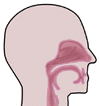  |
||
 |
Taste and smell function depend upon three major organ systems: (1) the sensory receptors which initially receive the physical components of tastes or odors, (2) the nerves along which the message from the receptors travel into the body, and (3) the brain which processes this information into meaningful sensory information about specific tastes or smells. Sensory receptors are complex structures which form a key part of how tastants and odors are received by taste buds and olfactory epithelial cells, respectively. Both taste buds and olfactory epithelial cells are comprised of several cell types. Each cell type performs a specialized task to support each specific organ and to act as an active conduit by which sensory information is received and transmitted to the neuron which then passes this information along to the brain. Sensory receptor cells comprise only a small number of the total cell number of either taste buds or olfactory epithelial cells. However, sensory receptor cells of both taste buds and olfactory epithelial cells are in themselves specialized complex structures. The “business end” of each of these receptor cells are formed into rod-like structures called cilia. They extend from the uppermost surface of these cells and act much like a periscope on a submarine surveying the milieu of the mouth (for taste) or nose (for smell). These cilia are embedded in fluid – saliva (for taste) and nasal mucus (for smell). These fluids are critical for maintenance of receptor function. The periscope like cilia monitor the sensory milieu of both saliva and nasal mucus. When a tastant enters the mouth it binds chemically to cilia on the taste receptor cell surface. This binding initiates the process of tasting. When an odorant enters the nose it binds chemically to cilia on the smell receptor cell surface. This binding initiates the process of smell. Cilia are in themselves biologically active structures. They are a complex anatomical and biochemical system comprised of a series of nine dual “tubules” around their periphery and two dual “tubules” in their central portion (a 9+2 arrangement). This system is under genetic control. For taste and smell perception the anatomy and biochemistry of this complex system must be intact for the receptors to function. We described the anatomy of cilia in the taste system in 1970: Mattern, C.F.T., Daniel, W.A., Henkin, R.I. The ultrastructure of the human circumvallate papilla I. Cilia of the papillary crypt. Anat. Rec. 167:175-182. We described the functional anatomy of cilia in taste buds in more detail in 1975: Paran, N., Mattern, C.F.T., Henkin, R.I. Ultrastructure of the taste bud of the human fungiform papilla. Cell. Tiss. Res. 161:1-10. We analyzed the complex ciliary function in the taste system in 1976: Henkin, R.I. Taste in man, in Scientific Foundations of Otolaryngology, (Harrison, D., Hinchcliffe, R., Eds.), Wm. Heinemann Medical Books, Ltd., London, England, pp. 469-483. We also described patients who exhibited abnormalities in ciliary function in 1993 when we published results of loss of smell function in patients with retinitis pigmentosa and with Refsum’s syndrome: Henkin, R.I. Evaluation and treatment of human olfactory dysfunction, in Otolaryngology (English, G.M. Ed.), Lippincott, Philadelphia, Vol.2, pp.1-86. Home
| The Clinic | Diagnosis
| Treatment | FAQ
| Press
|
|